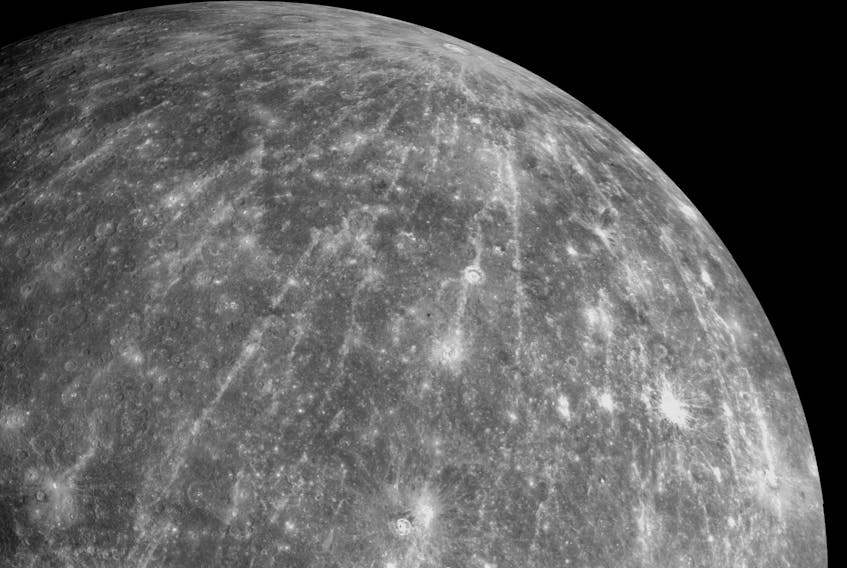This summer, I often spent the evening fishing for striped bass along the north shore of P.E.I. As my fishing buddies and I invariably stayed until it was dark, there was often the opportunity to view the constellations and planets visible in the evening sky at that particular time of the month.

As the beaches often had numerous people enjoying a late evening swim or just hanging out around a bonfire on the beach, some of them inevitably ended up talking about what could be seen in the night sky above them. Some nights, I found myself giving a brief tour of the night sky to a handful of complete strangers, pointing out various celestial objects overhead. Afterward, I realized that, to my amazement, the great majority of them, both native Islanders and people "from away," had no idea that you could see any planets in the night sky.
Since there is not much happening this month planet-wise (Jupiter and Saturn are still the only evening planets visible in the southwest sky at dusk), I thought I would write a series of information columns on the planets in the hope that people might become aware you can see most planets in the night sky and be able to recognize which planet(s) they are looking at on any given night throughout the year.
I'll start with our solar system's innermost planet - Mercury. Due to its rapid motion across the sky, this "star-like" object was named by the ancient Romans after the winged messenger to the gods, Mercury (Hermes to the ancient Greeks). The first records of this celestial object were by the ancient Assyrians in the 14th century BC. Interestingly, to the ancient Babylonians in the 1st millennium BC, it was known as "Nabu", a messenger to the gods in their mythology. To the ancient Chinese, it was "the Hour Star" associated with the direction north, and the phase of water in their system of metaphysics. In the Germanic pantheism, it was associated with the Norse god, Odin.
Mercury is the closest planet to the sun, orbiting at an average of .39 AU or about 58 million kilometres, and also the smallest (and least explored) planet, with a diameter of only 4,879 kms. It is unique amongst our solar system's planets, in that it is the only planet which doesn't rotate exactly once every year, instead rotating three times for every two orbits it makes around the sun. Due to Mercury's very thin atmosphere, it is the second hottest planet (after Venus) in our solar system, with daytime temperatures approaching 430C or more. It orbits the sun approximately every 88 Earth days, and one day on the planet equals 176 days on Earth. There are also no moons or rings around Mercury.
As it was in ancient times, Mercury is one of the five "bright" (naked-eye) planets visible in the night sky; the others are Mars, Venus, Jupiter and Saturn. It wasn't until 1543, when the Polish astronomer Nicolaus Copernicus published his sun-centered model of the solar system ('On the Revolution of the Heavenly Spheres'), that Mercury was regarded as a planet.
The first ground-based observations of Mercury didn't occur until the invention of the telescope in the early 1600s, and the planet was observed by the Italian astronomer, Galileo. Mercury (and Venus) are "inferior planets", meaning that they orbit the sun inside the orbit of Earth; all other planets are referred to as "superior planets,” as they orbit the sun outside that of Earth.
Due to its "inferior" orbit, Mercury will "transit" (pass in front of) the sun about every seven years. The first recorded transit of Mercury was in 1631. Mercury will transit the sun this November and again in November 2032. Telescopic observations of Mercury in 1639 showed different phases similar to our moon's phases, thus confirming that Mercury did, indeed, orbit the sun. An "occultation" is when a planet or other celestial object passes in front of another planet or celestial object. The first observed occultation of Mercury by Venus occurred on May 28, 1737, with the next not due until Dec. 3, 2133.
Only two spacecraft have visited Mercury. The 1974-1975 flyby of Mercury by NASA's Mariner 10 mission mapped almost half of the planet's surface before running out of fuel and drifting off to orbit around the sun. NASA's MESSENGER spacecraft, launched in 2004, achieved orbit around Mercury in 2011. Like its predecessor, it, too, eventually ran out of fuel, crashing into the planet in 2015. A joint European Space Agency (ESA) and Japanese mission - Bepi Colombo - launched last October is expected to arrive at Mercury in 2025.
Mercury is often very hard to see, even at the best of times. Due to its proximity to the sun, this diminutive planet can only be seen in the twilight, just after sunset in late winter and early spring, and just before sunrise in late summer and early autumn. Even then, you will need a clear, hazeless sky, an unobstructed view of the horizon, and, likely, binoculars; though once you have located it with the binoculars, you may then be able to spot it naked-eye.
As viewed from Earth, Mercury is never greater than 28 degrees from the sun. Mercury is currently too close to the setting sun to be seen, but along with Venus, will be visible in the latter part of October.
The full moon of Oct. 13 is often referred to as the "Hunter's Moon." At least in centuries gone by, hunters often used the light of the full moon to hunt late into the night, or use its guiding light to find their way home. In the Middle Ages, neo-pagans referred to October's full moon as the "Blood Moon". As it rises in early evening at this time of year, the moon will often take on a reddish (blood) colour, due to the fact that the light from the moon (reflected sunlight) must pass through more of the Earth's atmosphere, thereby scattering more of the blue light, and letting more of the red light through to our eyes.
Occurring as it did close to the Gaelic mid-month festival of Samhain, October's "Blood Moon" came to denote not only the changing of the seasons, but also the optimum time to communicate with dead loved ones, due to the thinning of the veil that separates the physical world from the spiritual world. Samhain eventually evolved into our present-day Halloween, with its celebration of all things ghoulish and macabre.
Next column - Venus, our "morning star", and, sometimes, our "evening star".
Until next time, clear skies.
Glenn K. Roberts lives in Stratford, P.E.I., and has been an avid amateur astronomer since he was a small child. He welcomes comments from readers, and anyone who would like to do so is encouraged to email him at [email protected].
Events:
Oct. 10 - Moon at apogee (farthest from Earth)
13 - Full "Hunter's/Blood" Moon









